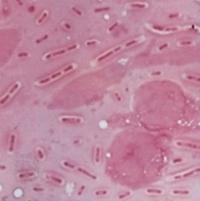Klebsiella pneumonia is a short, thick rod-shaped bacterium, a representative of the Enterobacteriaceae family. It is gram-negative, do not have flagella. But unlike other representatives of this family, polysaccharide capsules form in Klebsiella. These microorganisms are not demanding on nutrient media. For their cultivation, both general and differential diagnostic environments are used. Klebsiella has pronounced enzymatic activity. They break down glucose into acid and gas. There are several subspecies of Klebsiella, they are distinguished by biochemical characteristics. It is not difficult to distinguish them from other bacteria, representatives of enterobacteria, they do not have flagella, ferment sorbitol and do not cleave ornithine decarboxylase.
On
nutrient media, Klebsiella pneumonia is able to form mucous colonies. The pathogenic properties of this bacterium are completely determined by the degree of its ability to adhere. This quality of it completely depends on the capsular polysaccharide and proteins of the outer membrane. The presence of pili also plays an important role. If the adhesion process is successful for a pathogenic microbe, then it begins to multiply intensively and colonize enterocytes. A strong capsule of Klebsiella protects them from the harmful effects of phagocytic agents of the body. After the bacterium is destroyed, a strong endotoxin enters the bloodstream. But besides him, Klebsiella pneumonia is also capable of producing thermostable exotoxin. It enhances the removal of fluid from the body, while it is not absorbed properly through the intestinal wall. This plays a significant role in the development of acute intestinal diseases.

Klebsiella pneumonia is the causative agent of pneumonia, rhinoscleromas, ozena. It also causes damage to the intestines, genitourinary system, and meninges. In newborns, Klebsiella provokes
intestinal diseases and a toxicoseptic state. These microorganisms can cause outbreaks of nosocomial infections. The pneumonia caused by this pathogenic bacillus is characterized by the formation of several foci in the lungs. They can be connected into one large center. This is accompanied by profuse tissue mucus. This secreted mucus contains a large amount of Klebsiella. In addition to the lungs, other organs can be affected, and sepsis develops.
For the treatment of diseases caused by Klebsiella, the drug "Klebsifag
(Bacteriophage of Klebsiella pneumonia)" is used. This is an immunological drug. It has a specific ability to lyse
pathogenic bacteria. It is used to treat enteric and purulent diseases. Sepsis can be a consequence of infection with Klebsiella organs during surgical procedures. The purified Klebsiella pneumonia bacteriophage is also often prescribed for intestinal, urogenital
diseases, purulent-inflammatory infections, inflammation of the ear, nose, throat, upper respiratory tract and lungs. This drug is one of the best in the treatment of purulent-septic diseases of the newborn.